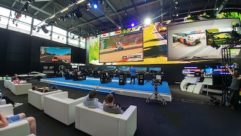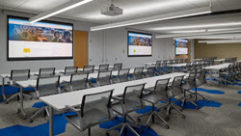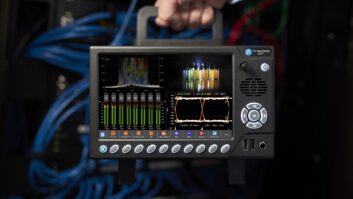
Automating History
Oct 1, 2007 12:00 PM,
By Carolyn Heinze
Integrated control enhances museum experience.

The Jamestown Gallery exhibit space presents museum visitors with an interactive experi-ence operated by an IP-based control system.
Located about a mile from its original site, the Jamestown Settlement in Williamsburg, Va., tells the story of America’s first English colonists and their interactions with Virginia’s Native Americans through gallery exhibits, film presentations, and impressive outdoor living-history displays recounting this integral period in 17th-century America. Not far away, the Yorktown Victory Center offers visitors timelines, thematic exhibitions, and outdoor demonstrations that concentrate on what life was like for ordinary men and women during the time of the American Revolution.
Several years ago, the Jamestown Settlement called upon the Virginia Beach-based office of AV systems-integration firm The Whitlock Group to install a turnkey AV solution for the facility’s main theater, which uses a Crestron control system to replay a short movie in 15-minute intervals and to automatically adjust the lighting levels and doors.
Systems integration work on the facility resumed recently when The Whitlock Group concluded an installation in the Jamestown Gallery, a multi-exhibit space featuring a full Crestron control system that oversees functionality for the AV technology in the exhibit.
INTERACTING WITH HISTORY
“They wanted something user-friendly, and something that would allow them to do something different than just display artifacts,” says Rodney Coronel, account manager at The Whitlock Group. “There are some interactive exhibits with newer content, as opposed to a traditional museum where there is a lot of reading involved. They are doing a lot with film and interactive displays.”
Therefore, a Crestron eControl IP-based control system enables wireless remote operation of all systems on the site.

The theaters that are part of the Jamestown Settlement exhibits are all run by one Crestron Pro2 control processor, which handles everything from starting the high-definition players to interfacing with the lighting cues.
“There are approximately 16 exhibits in there that are tied to the Crestron control system,” says Phil Raymond, AV systems design engineer at The Whitlock Group. “Everything is automated: It is set up so that it comes on at a certain time and goes off at a certain time in the evening, and it runs all day long.”
According to Brian Eckenroth, senior project manager at The Whitlock Group, the new gallery features three exhibits with interactive audio, one of which also features lighting. All the exhibits feature the same equipment — two Alcorn McBride AM4/B audio players, an Extron MPA 122 amplifier, and two Soundstik handheld loudspeakers from Vista Group that are triggered magnetically. “The Crestron detects this trigger and tells the Alcorn McBride to play the audio track,” Eckenroth says. “When the Soundstik is hung up, the Crestron stops playback of the track.”
The audio tracks feature background sounds such as birds, water movement, or chopping trees. One of the tracks also features background audio that changes to match day and night scenes.
Raymond notes that the open-concept configuration of the gallery called for highly directional loudspeakers.
“Since the gallery is one big, open box, there had to be a lot of point source loudspeakers in there that would still fill a large space without bleeding over into the rest of the gallery,” he says. The Whitlock Group’s solution was to install a number of SoundTube RS600i 6.5in. coaxial open ceiling- and surface-mount loudspeakers.

Visitors to the “Contrasting Technogies” exhibit can use an interactive touchscreen to choose the media they want to see. A Magenta Research video distribution system retrieves their choice and plays it back on a 42in. Panasonic plasma display.
The “Contrasting Technology” exhibit is equipped with a 42in. Panasonic TH-42PHD7UY plasma, a touch-sensitive 19in. NEC LCD1980SXBX monitor, and a Tannoy IW6-TDC in-wall loudspeaker. The NEC monitor allows visitors to choose one of three options. The monitor then communicates their choice via a Magenta Research MultiView 350 video distribution system to a Dell GX280 computer that stores the media. The chosen media is displayed on the 50in. plasma, with audio played through the loudspeaker.
The “African Object Theater,” which is equipped with three Panasonic PT-DW7000K projectors and Soundtube STB-CM690i loudspeakers with an 8-channel CX168 amplifier from QSC, does not feature hands-on functionality, but a Crestron Pro2 control processor controls its lighting to correspond with the movie, displaying the different exhibits as they appear in the movie.
“The Crestron control system in the museum is very detailed,” Eckenroth says. “It is constantly controlling the interactive displays as they are in use all day. There are controls to allow for extended times in the busy visitor season. The wireless controller allows the [Jamestown staff] to walk around from exhibit to exhibit and make on-the-fly adjustments for sound levels if needed. Also, for special occasions, any movie being displayed can be stopped and restarted to allow for questions.”
The control system at Jamestown is linked with other systems at the Yorktown Victory Center, as well, allowing Jamestown’s AV specialist, Jan Heuvel, to monitor and control the Yorktown systems from his office at the principal site.
“I can sit in my office and check the system out,” Heuvel says. “We have a lot of functions here, which are after hours, so we need to turn the system on and off and put it back into automatic mode.” He adds that Crestron RoomView software helps him to keep track of lamp life on the projectors.
Raymond adds that Heuvel and his team have manual control over the system when necessary — a feature that comes in handy during special events.
“We have given him manual control over everything, as well as full automation, so that if, for example, they have a large group coming in for an exhibition, he can restart things and make the system work without having the automation take control,” Raymond says. “They wanted it to be automatic and user-friendly, but they also wanted manual control.”
Heuvel says that the simplicity of the system makes it easier for other staffers to operate it, as well. “We tried to simplify the touchpanel,” he says. “If something goes down, they are able to turn the system back on. I don’t find it a hard system to use — it’s pretty simplified.”

The Whitlock Group built a turnkey AV solution for the facility’s main theater to control and replay a short movie in 15-minute intervals and to automatically adjust lighting levels. The IP-based control system is also connected with other systems at the Yorktown Victory Center for centralized monitoring.
LIGHTS AND ACTION
Bill Schafer, director of product and channel development at Crestron Electronics in Rockleigh, N.J., notes that museums such as the facility at Jamestown are demonstrating considerable use of automation technology in all aspects of their operations these days. Behind the scenes, control technology is used for primary building functions, such as lighting and HVAC. “One area is running the building: We have a lot of lighting control systems that are used to manage the property as well as environmental controls,” Schafer says.
As technology continues to progress, how museum visitors interact with various kiosks and displays will grow more sophisticated, as well. After a decade of rising dominance, the convergence of AV and IT remains an issue that still retains significance. Today, however, Schafer says there is another convergence taking place: that of lighting and video.
“Those two are merging, and I believe that they will have a future in a lot of museums,” he says, noting that the technology exists to enable lights to play back video, or to have their color temperature adjust in accordance with a video clip or even an audio clip. “They are definitely making an impact in the theatrical world, and I believe that [the technology] will have an impact in the museum market as well.”
HIDDEN CONTROL
In the end, the pressure in Jamestown the installation stemmed from its historical importance. “It isn’t just any museum — it’s Jamestown,” Eckenroth says. “There was a lot of pressure for this to all work and look and sound the best. After all, the Queen and President Bush came to visit for the 400th-anniversary celebration.”
This made it even more important to ensure that the AV and control technology was kept out of sight. “Nearly everything is invisible,” Eckenroth says. “I spent more time hiding and disguising equipment so it could not be seen than probably anything else. This museum flows well. All exhibits play their part and tell a story. The equipment we installed fit perfectly into creating what the customer wanted. The museum is unique for having actual historical artifacts on display. The installation is unique in that it has to be able to work around all of those irreplaceable items, and in the large number of audio and video files that have to work together to tell the story of our country.”
Carolyn Heinzeis a freelance writer/editor. She can be reached atcarolynheinze.blogspot.com.









